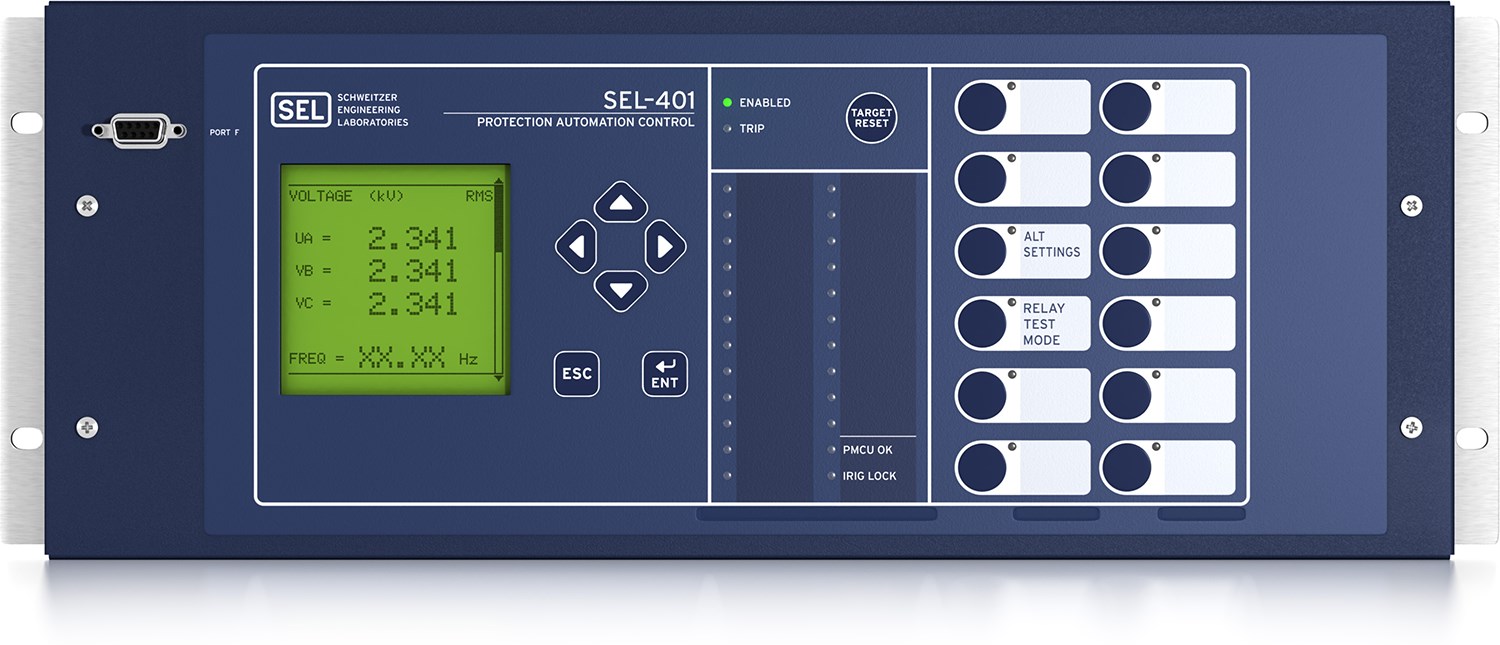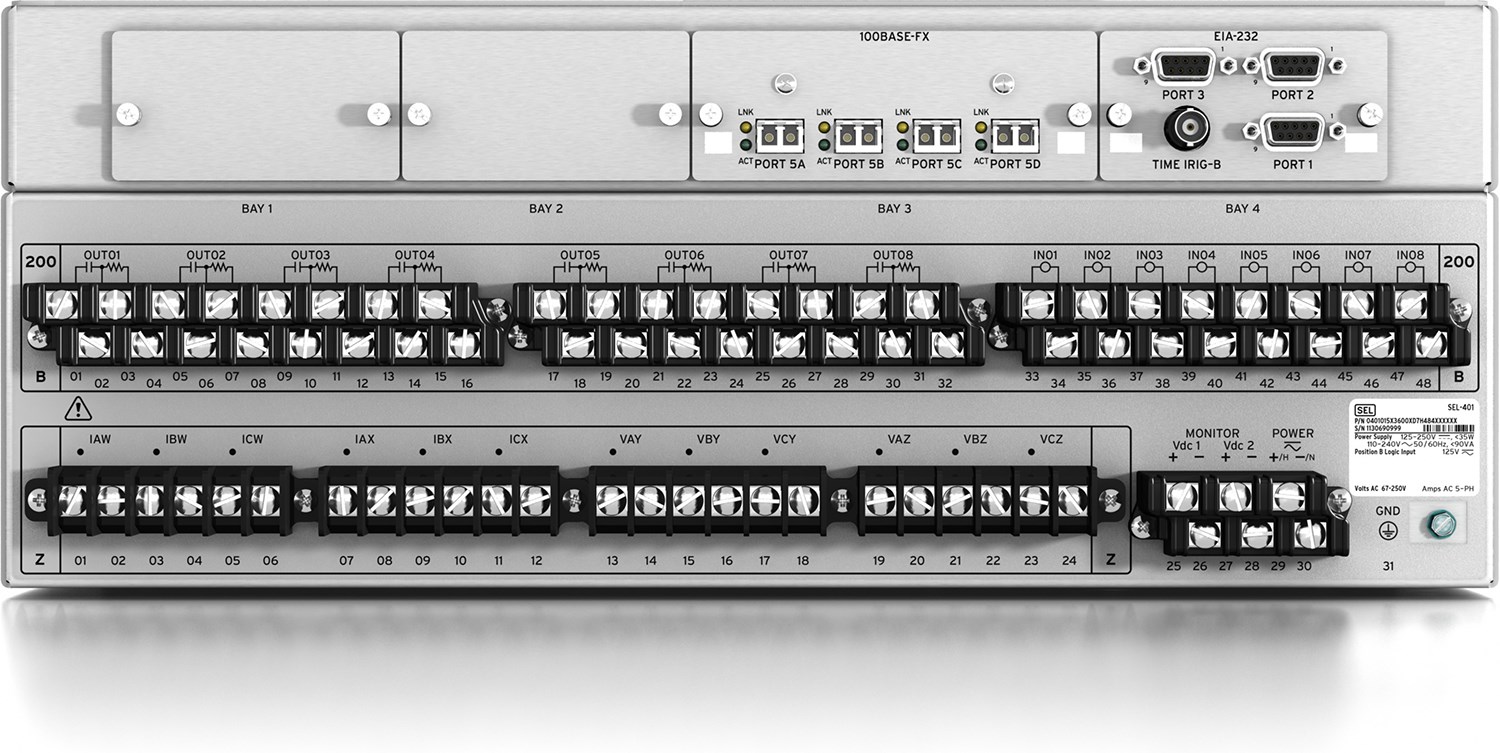
SEL-401
Protection, Automation, and Control Merging Unit
Apply the SEL-401 Protection, Automation, and Control Merging Unit for substations with IEC 61850-9-2 Sampled Values (SV) systems. Sample analog data, such as currents and voltages, then publish those data to a fiber-based Ethernet network for use in other IEDs, such as compliant SEL-400 series relays. The SEL-401 publishes SV data to the process bus network and also provides local protection. Use the built-in phase-overcurrent and breaker failure protection to provide backup in case of communications system failures.
Starting At
$4,620IEC 61850-9-2 SV Implementation—Place the SEL-401 out in the yard right next to primary equipment. The SEL-401 digitizes analog signals from primary equipment and then transmits them to the control house via a fiber-based Ethernet network. It can publish as many as seven outgoing data streams of IEC 61850-9-2 SV data to any relays that subscribe to SV. The merging unit can synchronize the data using the IEEE 1588 Precision Time Protocol Version 2 (PTPv2) or an IRIG-B time input. Improve system availability in SV applications with the Parallel Redundancy Protocol (PRP) or seamless failover using a five-port Ethernet card.
Integrated Protection—Provide local breaker failure and phase overcurrent protection during a loss of the precise time signal or communication to a main substation relay. The SEL-401 uses high-speed (5/8-cycle) open-pole detection logic to reduce coordination times for critical breaker failure applications.
Sequential Events Recorder (SER)—Record the last 1,000 entries, including setting changes, when the merging unit turns on, and selectable logic element operations.
Dual-Breaker Schemes—Accommodate two sets of three-phase currents and two sets of three-phase voltages to support substations with dual-breaker schemes. You can combine currents within the merging unit from two sets of CTs for protection functions but keep them separately available for monitoring and station integration applications.
Oscillography—Record voltages, currents, and internal logic points at up to an 8 kHz sampling rate. Phasor and harmonic analysis features allow the investigation of merging unit and system performance.
Flexible Communications Options—Use small form-factor pluggable (SFP) transceivers on designated process bus, station bus, and engineering access ports in the five-port Ethernet card. Choose between single- and multimode communications options for increased flexibility. All ports support 100 Mbps SFP transceivers, and process bus ports also support 1 Gbps SFP transceivers.
Features
-
- 1
Control and settings are divided into seven relay access levels for increased security. The relay has separate breaker, protection, automation, and output access levels, among others. You can set unique passwords for each access level.
- 2
The front-panel display provides status indication and control of as many as ten disconnects. The relay offers control for up to two breakers and provides status indication for up to three breakers.
- 3
User-selectable mimic screens are displayed on the front panel in one-line diagram format. The one-line diagram allows up to six user-configurable labels for disconnect switches, breakers, bay name, and display for up to six analog quantities.
- 4
Easy-to-use keypad aids simple navigation and set-point adjustment.
- 5
Up to 24 programmable target LEDs with user-configurable labels alert operators in the substation to faulted phases, the relay’s status, and element operation.
- 6
Programmable operator pushbuttons with user-configurable labels offer front-panel customization.
123456
-
-
- 1
Vertical or horizontal, panel-mount or rack-mount hardware package. The size options available are 4U, 5U, or 6U and allow you to order up to three I/O boards (shown as 5U horizontal rack mount with two I/O boards).
- 2
Ethernet communications protocols include FTP, Telnet, synchrophasors, DNP3 LAN/WAN, PRP, IEEE 1588 PTPv2, IEC 61850-9-2, and IEC 61850 Edition 2. Select a five-port Ethernet card for dedicated process bus, station bus, and engineering access ports.
- 3
Three EIA-232 serial ports for Mirrored Bits communications, SCADA, and engineering access provide flexibility to communicate with other devices and control systems. The ports include demodulated IRIG-B for precise-time input.
- 4
Six current and six voltage analog inputs, orderable in standard terminal blocks (shown) or a Connectorized hardware configuration.
- 5
Power supply options include 24–48 Vdc; 48–125 Vdc or 110–120 Vac; or 125–250 Vdc or 110–240 Vac.
12345
-
Details
SEL SV-Based Solutions
Based on the IEC 61850 standard, SV-based solutions maximize flexibility and interoperability. The SEL-401 Protection, Automation, and Control Merging Unit digitizes analog signals from primary equipment and sends them using the Sampled Values protocol to an SV relay in the control house. Because all SEL SV devices are compliant with IEC 61850-9-2 and the UCA 61850-9-2LE guideline, the SEL-401 can be used with other manufacturers’ IEC 61850-compliant units.
The SEL-401 includes built-in phase overcurrent and breaker failure protection. This allows you to have the protection right next to the primary equipment for increased speed and reliability.
Self-Test Capabilities
The SEL-401 self-test capability, which consists of simulating SV network traffic, allows you to verify network connections between SEL SV devices during commissioning or testing.
Automation and Control
Take advantage of SELogic control equations with math and comparison functions for control applications.
The SEL-401 includes 32 programmable elements for enhanced automation features regarding local control, remote control, protection latching, and automation latching.
Serial and Ethernet links let you efficiently transmit key information, such as metering data, IEEE C37.118 synchrophasors, SER reports, breaker monitoring, merging unit summary event reports, and time synchronization.
Metering and Monitoring
Employ extensive metering capabilities, such as instantaneous metering, power/energy metering, and comprehensive reporting of SV communications streams. Event reports and the SER log provide valuable time-stamped information for commissioning and post-event analysis.
Synchrophasors
Provide real-time system state measurement with time-synchronized voltages and currents in the IEEE C37.118 standard format. Combined with SEL-5078-2 synchroWAVe Central Software or third-party software, this enables you to view and analyze system phase angles, load oscillations, voltage profiles, and other critical system information.
Flexible Ethernet Communications
The four- and five-port Ethernet communications card options enable you to communicate using a variety of protocols, including FTP, HTTP, DNP3, PTPv2, PRP, Telnet, synchrophasors, and IEC 61850 Edition 2.
The SEL-401 can be configured with a five-port Ethernet card supporting PRP or failover functionality to increase system availability, as well as PTPv2 on process bus or station bus ports for time synchronization. Use network monitoring features in the relay to further improve system availability by actively monitoring each redundant path to detect communications network failures.
The five-port card also features dedicated ports and IP addresses for station bus and engineering access networks to provide selective access control. All ports support SFP transceivers. Single- and multimode communications options provide increased flexibility. All ports support 100 Mbps SFP transceivers, and process bus ports also support 1 Gbps SFP transceivers.
Serial Communications
All four independent EIA-232 serial ports support ASCII, Compressed ASCII, Extended Fast Meter, Fast Operate, Fast SER, enhanced SEL Mirrored Bits communications, Ymodem, and DNP3 Level 2 Outstation as well as dial-out, Virtual Terminal, and communications with SEL-2600 series RTD modules.
Simplified Settings Management
Use acSELerator QuickSet SEL-5030 Software to develop relay settings offline and program SELogic control equations. Or configure the SEL-401 using SEL Grid Configurator software, which increases efficiency and improves settings insights. It features a spreadsheet-style editor, protection visualization, comprehensive reporting, custom filters, and multiple-device settings management.
Minimum Software Version
| Product | Revision | Z Number | acSELerator QuickSet Version | SEL Grid Configurator Version |
|---|---|---|---|---|
| SEL-401 | R410-V0 | 108 | 5.1.0.x | |
| SEL-401 | R409-V0 | 107 | 4.4.2.4 | |
| SEL-401 | R408-V0 | 106 | 4.0.1.x | |
| SEL-401 | R407-V1 | 105 | 1.3.1.x | |
| SEL-401 | R407-V0 | 105 | 1.3.1.x | |
| SEL-401 | R406-V1 | 104 | 6.8.1.0 | |
| SEL-401 | R405-V1 | 103 | 6.7.5.3 | |
| SEL-401 | R403-V0 | 101 | 6.7.0.2 | |
| SEL-401 | R402-V0 | 100 | 6.7.0.2 | |
| SEL-401 | R400-V0 | 100 | 6.7.0.2 |
Latest Firmware Versions
There are no firmware versions available for this product.
| Product | Revision | Firmware ID | Date Available | Serial Number |
|---|---|---|---|---|
| SEL-401 | R410-V1 | SEL-401-R410-V1-Z108003-D20240229 | 3/15/24 | ~12407400001 |
The Firmware IDs for older versions of the firmware can typically be found in Appendix A of the instruction manual.
Minimum Software Version
| Product | Revision | Z Number | acSELerator QuickSet Version | SEL Grid Configurator Version |
|---|---|---|---|---|
| SEL-401 | R410-V0 | 108 | 5.1.0.x | |
| SEL-401 | R409-V0 | 107 | 4.4.2.4 | |
| SEL-401 | R408-V0 | 106 | 4.0.1.x | |
| SEL-401 | R407-V1 | 105 | 1.3.1.x | |
| SEL-401 | R407-V0 | 105 | 1.3.1.x | |
| SEL-401 | R406-V1 | 104 | 6.8.1.0 | |
| SEL-401 | R405-V1 | 103 | 6.7.5.3 | |
| SEL-401 | R403-V0 | 101 | 6.7.0.2 | |
| SEL-401 | R402-V0 | 100 | 6.7.0.2 | |
| SEL-401 | R400-V0 | 100 | 6.7.0.2 |
400G 401 - Software Tab
Configuration Software
acSELerator QuickSet SEL-5030 Software
QuickSet is a tool for engineers and technicians to quickly and easily configure, commission, and manage power system devices. QuickSet includes a Graphical Logic Editor and a device template tool to reduce configuration time and streamline deployment.
Learn more and download on the QuickSet software page.
SEL-5037 Grid Configurator Software
SEL Grid Configurator is a no-charge software tool for engineers and technicians to create, manage, and deploy settings for SEL power system devices.
Learn more and download on the Grid Configurator software page.
SEL-5032 acSELerator Architect SEL-5032 Software
Architect allows users to configure and document IEC 61850 systems that include GOOSE, Sampled Values (SV), or Manufacturing Message Specification (MMS) communications. Architect automatically compares SCL files with IEC 61850 requirements to ensure standard compliance.
Learn more and download on the Architect software page.
Automated Data Collection
SEL Data Management and Automation (DMA) Application Suite
Available on the Blueframe platform, DMA applications automatically collect, store, and manage device-specific information like oscillography, Sequence of Events (SOE) data, device settings, and property information. They also provide automated password rotation and streamlined device audits.
Learn more on the DMA software page.